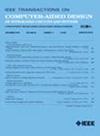一种基于cnn的并行决策冗余分析方法
IF 2.9
3区 计算机科学
Q2 COMPUTER SCIENCE, HARDWARE & ARCHITECTURE
IEEE Transactions on Computer-Aided Design of Integrated Circuits and Systems
Pub Date : 2025-01-09
DOI:10.1109/TCAD.2025.3527905
引用次数: 0
摘要
内存单元密度和容量的增加导致了更多的故障单元,需要使用冗余的内存行和列行进行修复。然而,现有的冗余分析(RA)算法面临着RA时间随故障单元数量呈指数增长的关键问题。此外,不能同时导出多个存储芯片的RA解决方案。本文提出了一种基于卷积神经网络(CNN)的RA方法。本文提出的RA算法还包括预处理,以提高训练精度。利用多标签分类方法预测故障图上的解的位置。而且,并行解决策方法保证了即使CNN没有找到正确的RA解,仍然可以推导出准确的最终解,并且使用PyCUDA来并行处理多个存储器。从实验结果来看,该RA的归一化修复率为100%。提出的RA的RA时间不受故障数量的影响,而受CNN执行时间的影响。此外,利用图形处理单元并行处理,可以快速同时导出多个存储器的RA解决方案。综上所述,可以实现高成品率和低测试成本。本文章由计算机程序翻译,如有差异,请以英文原文为准。
A Novel CNN-Based Redundancy Analysis Using Parallel Solution Decision
The increase in memory cell density and capacity has resulted in more faulty cells, necessitating the use of redundant memory row and column lines for repairs. However, existing redundancy analysis (RA) algorithms face a critical issue that RA time increases exponentially with the number of faulty cells. Furthermore, RA solutions for multiple memory chips cannot be derived simultaneously. In this study, a novel RA method is proposed using a convolutional neural network (CNN). The proposed RA algorithm also includes preprocessing to improve training accuracy. The solution locations on the fault map are predicted using multilabel classification. Moreover, parallel solution decision methods ensure that even if the CNN does not find the correct RA solution, an accurate final solution can still be derived, and PyCUDA is used to process multiple memories in parallel. From the experimental results, the normalized repair rate of the proposed RA is 100%. The RA time of the proposed RA is not affected by the number of faults but rather by the CNN execution time. Moreover, RA solutions for multiple memories can be quickly derived simultaneously by utilizing graphic processing unit parallel processing. In conclusion, a high yield and low test cost can be achieved.
求助全文
通过发布文献求助,成功后即可免费获取论文全文。
去求助
来源期刊
CiteScore
5.60
自引率
13.80%
发文量
500
审稿时长
7 months
期刊介绍:
The purpose of this Transactions is to publish papers of interest to individuals in the area of computer-aided design of integrated circuits and systems composed of analog, digital, mixed-signal, optical, or microwave components. The aids include methods, models, algorithms, and man-machine interfaces for system-level, physical and logical design including: planning, synthesis, partitioning, modeling, simulation, layout, verification, testing, hardware-software co-design and documentation of integrated circuit and system designs of all complexities. Design tools and techniques for evaluating and designing integrated circuits and systems for metrics such as performance, power, reliability, testability, and security are a focus.

 求助内容:
求助内容: 应助结果提醒方式:
应助结果提醒方式:


